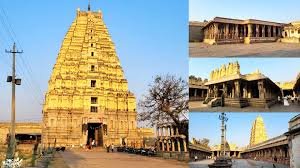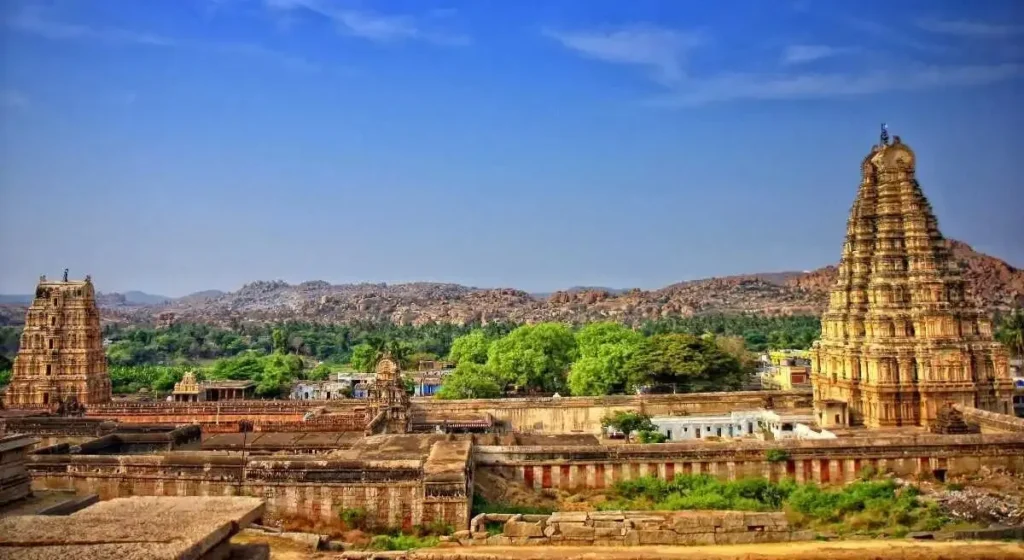Virupaksha Temple, nestled in the majestic ruins of Hampi, Karnataka, is a living testament to South India’s spiritual eminence and architectural brilliance. Known for its uninterrupted worship since the 7th century, this revered shrine is dedicated to Lord Shiva, drawing devotees, curious travellers, and history enthusiasts from around the globe.
Location and Accessibility
Virupaksha Temple is located in the heart of Hampi, on the southern bank of the Tungabhadra River, about 350 km from Bangalore. Hospet Railway Station, 13 km away, is the nearest major railhead. Bellary (approximately 39 km by road) is the closest domestic airport, while Bangalore International Airport (355 km) serves international travellers. Visitors can reach Hampi by road via state-run buses from Bangalore, Bellary, Hospet, and Goa, or by hiring cabs and taxis. The temple is just a short walk or quick auto-rickshaw ride from Hampi bus stand, making it easily accessible for tourists.
Key Details:
History of Virupaksha Temple
Virupaksha Temple’s history can be traced back to the 7th century CE, when it started as a humble shrine at the Virupaksha-Pampa sanctuary. Evidence from inscriptions and religious texts points to continued expansion under the Chalukyan and Hoysala dynasties, but it was the Vijayanagara Empire (14th-16th centuries) that transformed the temple into a grand complex. Chieftain Lakkana Dandesha supervised much of the construction under King Deva Raya II, and later contributions were made by rulers like Krishnadevaraya. Even after the destruction of Hampi in 1565, the temple persisted as a vital religious site, preserving centuries-old traditions. Further renovations in the 19th century restored parts of this architectural marvel, keeping its rich legacy alive.
Cultural Significance
More than a place of worship, Virupaksha Temple served as a cultural hub during the heights of the Vijayanagara Empire. Artists, scholars, and musicians thrived here, contributing to South India’s art and culture. The temple still hosts music and dance performances during festivals, especially during the annual Virupaksha Utsav, attracting diverse crowds. As part of the UNESCO World Heritage Site of Hampi, Virupaksha Temple represents a living heritage that continues to inspire and unite people from varied cultural backgrounds.
Temple Architecture and Features
Virupaksha Temple is the crown jewel of Vijayanagara architecture, built primarily from sandstone and granite. The main entrance’s towering gopuram stands nearly 50 meters tall, dominating Hampi’s skyline. Inside, the temple complex boasts a central sanctum, expansive pillared halls, three ante chambers, and intricately carved pillars depicting Hindu deities and mythological stories. The temple houses the revered Shivalinga symbolizing Lord Virupaksha, surrounded by shrines dedicated to other deities. The temple’s unique ceiling paintings, dating to the 14th and 16th centuries, and the extensive stone inscriptions offer insights into its rich history and artistry.

Rituals, Festivals, and Living Heritage
Worship takes place daily at Virupaksha Temple, with rituals and ceremonies still performed in their original forms. The annual Virupaksha Festival and the marriage festivities of Virupaksha and Pampa in December are major events that draw thousands of pilgrims. Special pujas, aartis, and religious processions occur throughout the year, making the temple a vibrant center for spiritual life. Despite centuries of change and the destruction of many surrounding temples, Virupaksha continues to function as a living sacred geography, central to the region’s Shaivite tradition.
Visitor Experience and Tourism
The temple is open every day, typically from 6:00 AM to 1:00 PM, and 5:00 PM to 9:00 PM. There is no entry fee, but special darshan and camera use incur small charges. Visitors often spend 1-2 hours exploring the site, with a recommended duration of up to three hours for those who wish to soak in its ambiance fully. Guided tours, cultural performances, artisan craft displays, and local cuisine enhance the overall experience. Accommodation is widely available in Hampi and Hospet, ranging from luxury resorts to budget-friendly lodges and homestays, ensuring comfort and convenience for all types of travelers.
Tourism Revenue and Economic Impact
Over 3.5 million visitors annually flock to Hampi, with Virupaksha Temple as the primary draw. The temple and its surrounding heritage zone generate substantial revenue through guided tours, artisan crafts, homestays, eco-tourism, and local markets. Tourism supports livelihoods in Bellary, Hospet, and nearby villages, making heritage tourism the backbone of the local economy. Seasonal peaks, especially during religious festivals and winter months, lead to high occupancy rates and bustling markets, while preservation initiatives work to sustain the site’s uniqueness for future generations.
Conservation and Preservation
Virupaksha Temple faces challenges such as weathering, structural decay, and pressures from mass tourism. Preservation efforts led by government authorities, NGOs, and community groups focus on restoring damaged architecture, regulating visitor flows, and maintaining the temple’s authenticity. As a recognized UNESCO site, Virupaksha benefits from international attention and funding, though balancing living heritage and archaeological conservation requires ongoing collaboration among all stakeholders.
FAQs About Virupaksha Temple
What are the timings of Virupaksha Temple?
The temple is open from 6:00 AM to 1:00 PM and 5:00 PM to 9:00 PM daily, providing ample time for worship and sightseeing.
Is there an entry fee to visit Virupaksha Temple?
There is no general entry fee. However, special darshan and photography incurs small charges – ₹25 for Special Darshan and ₹50 for cameras.
What is the dress code for visiting the temple?
Visitors are expected to wear modest attire. Men are recommended to wear dhotis or pants and shirts, while women are encouraged to wear sarees, salwar kameez, or similarly respectful clothing.
How do I reach Virupaksha Temple from Bangalore?
Virupaksha Temple is located about 350 km from Bangalore. Take a road journey via NH67, trains to Hospet (13.4 km from Hampi), or fly to Bellary (39 km away) and continue by taxi or bus.
What are the main festivals celebrated at Virupaksha Temple?
Virupaksha Festival and the marriage festivities of Virupaksha and Pampa in December are celebrated with grandeur, attracting thousands of devotees.
Is accommodation available near the temple?
Yes, various hotels, resorts, guest houses, and homestays cater to different budgets in Hampi and Hospet.
What makes Virupaksha Temple unique?
Its uninterrupted worship since the 7th century, stunning Vijayanagara architecture, vibrant festivals, and status as Hampi’s only continuously functioning temple set Virupaksha apart.
How does tourism contribute to the local economy?
Tourism centered around Virupaksha Temple creates jobs in guided tours, hospitality, crafts, and cultural events, generating significant revenue and supporting livelihoods in the region.
Hampi’s Spiritual Beacon Continues to Shine Bright
Virupaksha Temple remains a beacon of spirituality, history, and culture, anchoring the living heritage of Hampi and the collective identity of millions. As both a vibrant pilgrimage site and a global tourist attraction, it offers transformative experiences that blend the past with the present, inviting visitors to marvel at its grandeur and immerse in its divine atmosphere. This temple is a must-visit for anyone keen to explore India’s heritage or embark on a journey of personal discovery.
